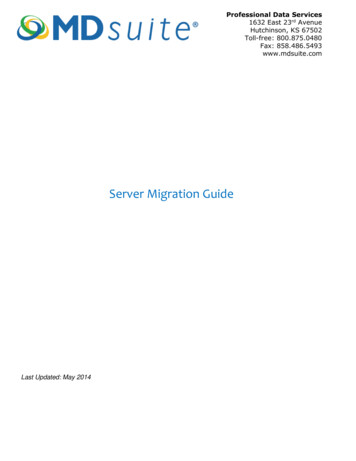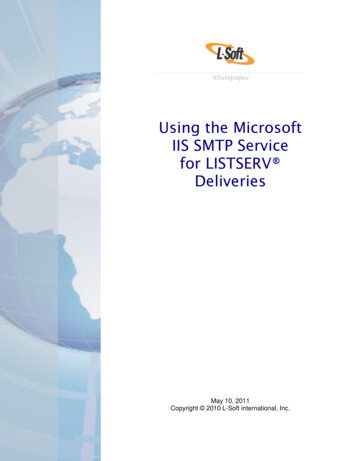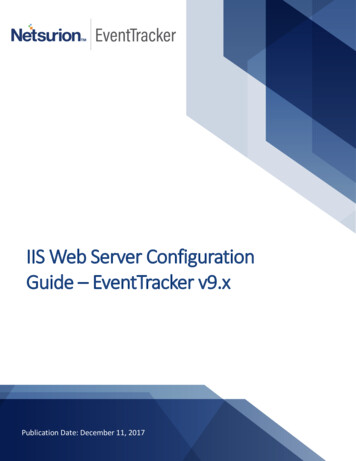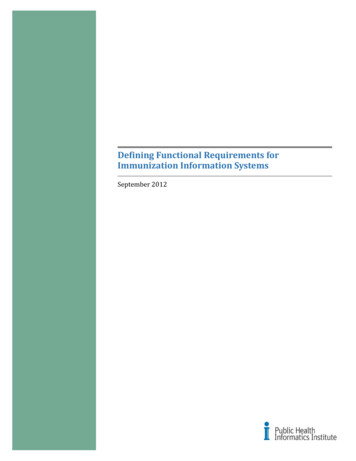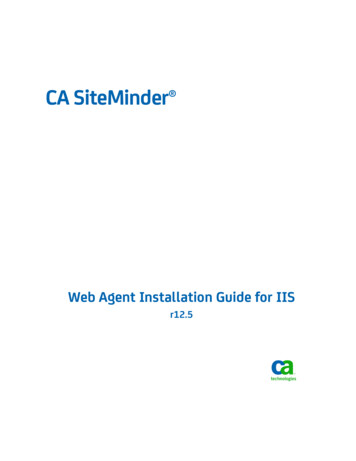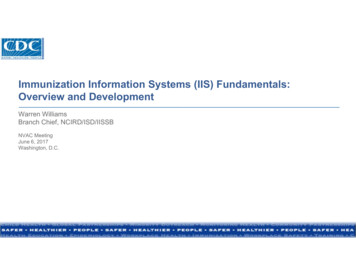
Transcription
Immunization Information Systems (IIS) Fundamentals:Overview and DevelopmentWarren WilliamsBranch Chief, NCIRD/ISD/IISSBNVAC MeetingJune 6, 2017Washington, D.C.
Overview What are IIS? Functionalities/Capabilities of IIS Data collection and applications State of IIS across the United StatesIIS Vision: Real-time, consolidated immunization data and services for all agesare available for authorized clinical, administrative, and public health users andconsumers, anytime and anywhere1
What are Immunization Information Systems (IIS)? Immunization information systems (IIS) are confidential, population-based,computerized databases that record all immunization doses administered byparticipating providers to persons residing within a given geopolitical area Why are IIS important? At the point of clinical care, an IIS can provide consolidated immunization histories foruse by a vaccination provider in determining appropriate client vaccinations At the population level, an IIS provides aggregate data on vaccinations for use insurveillance and program operations, and in guiding public health action with the goals ofimproving vaccination rates and reducing vaccine-preventable disease Community Preventive Services Task Force recommends immunization informationsystems on the basis of strong evidence of effectiveness in increasing vaccination ms*All States will have an IIS with New Hampshire pilot test late summer 20172
IIS Functions Functional standards are intended to identify operational, programmatic, andtechnical capacities that all IIS should achieve by the end of 2017 Some standards are environmental, and can only be implemented in conjunction withthe broader Department of Health or State/Local infrastructure The Functional Standards are intended to reflect necessary functions, whether thosefunctions are implemented by the IIS program or others In some cases, current law or policy may preempt full implementation unlesschanged. In these instances, an unmet standard may serve as a suggestion forpossible revisions to such law or policy The 2013-2017 Functional Standards can be found at s.html3
Why IIS are Important By two years of age, over 20% ofthe children in the U.S. typicallyhave seen more than onehealthcare provider, resulting inscattered paper medical records. Immunization informationsystems (IIS) help providers andfamilies by consolidatingimmunization information intoone reliable source.Patients with at least 1 immunization fromDane County Health Department, Wisconsin4
Current IIS EnvironmentImmunizationProgramGrowthDrivers in BroaderEnvironment in whichIIS OperateIIS StakeholdersFundingSourcesProvidersReturn onInvestmentsIIS DataDemandsIncreased Emphasison Interoperabilityand StandardizationEHR Vendors,HIEs,Private HealthNetworksPublic HealthResearchersHealth Plans,ACOs,MMCOsMeaningfulUse andMACRAImzPrograms(e.g. AFIX, VFC)State PublicHealth (e.g.Surveillance,WIC)IISStateVariationDay Care f EHRsConsumers“IIS – many things tomany people”FederalOrganizations(e.g. CDC,CMS, NVPO,ONC)Personal HealthRecords AccessVital RecordsWorkforceHealth InformationExchange Networks5
IIS Data Sources6
IIS PlatformsEnvision (15) ArkansasColoradoDelawareKansasKentuckyNevadaNew MexicoPhiladelphiaPacific Islands (6)San AntonioSTC (10) AlaskaArizonaIndianaLouisianaMississippiNew HampshireTennesseeWashingtonWest VirginiaWyoming The remaining 21 federally funded immunization programs eitherdeveloped their own IIS or are supported by a smaller vendor.WIR (18) sotaMontanaNebraskaNew York StateNorth CarolinaOregonPuerto RicoTexasU.S. Virgin IslandsVirginiaWisconsin7
IIS Interoperability Interoperability between IIS and EHRs can improve surveillance whilesimultaneously reducing administrative burden Enhancing EHR-IIS interoperability improves data quality challenges byaddressing: Accuracy Timeliness Completeness EHR-IIS interoperability supported by CDC include: Educating EHR vendors on requirements to build IIS functionality into EHRsystems Developing capacity for HL7 2.5.1 Implementing bi-directional data exchanges through a web services interface Assessing IIS progress towards meeting IIS Functional Standards8
IIS Challenges and OpportunitiesIIS ChallengesIncomplete data reportingIIS Strategic OpportunitiesEnhance IIS PerformanceDifferences in performancelevels across IISPromote Adherence to IIS StandardsDiversity in stakeholderstandards, technologies andpoliciesSustain the IIS CommunityStandards ImplementationVariabilityInfluence and Monitor the Health ITEnvironment9
IIS Participation – Legal/Structural LandscapeA CDC legislative survey of all states plus Washington DC revealed that: 47 of 50 states plus Washington DC are lifespan IISs 42 of 50 states plus Washington DC are opt-out IISs for adults IIS interstate data sharing remains an issue Martin, DW et al. Immunization Information Systems: A Decade of Progress in Law and Policy. Journal ofPublic Health Management & Practice: May/June 2015 - Volume 21 - Issue 3 - p 296–303 (online open-access 0/Immunization Information Systems A Decade of.10.aspx)10
Percentage of children aged 6 years participating in an ImmunizationInformation System -- United States, five cities§, and D.C., 2015Text Version 95% (31 awardees)75% - 94% (18 awardees)50% - 74% (5 awardees)25% - 49% (1 awardee) 25% (0 awardee)No IIS (1 awardee)No data (0 awardees)National Participation: 92% (excluding Territories)Source: CY2015 IISAR§ Chicago, IL; Houston, TX; New York City, NY; Philadelphia, PA; San Antonio, TX*Awardees are federally funded immunization programs.11
Percentage of adults aged 19 years participating in an ImmunizationInformation System -- United States, five cities§, and D.C., 2015Text Version 95% (1 awardees)75% - 94% (5 awardees)50% - 74% (17 awardees)25% - 49% (20 awardee) 25% (10 awardee)No IIS (1 awardee)No data (2 awardees)National Participation: 39% (excluding Territories)Source: CY2015 IISAR§ Chicago, IL; Houston, TX; New York City, NY; Philadelphia, PA; San Antonio, TX.*Awardees are federally funded immunization programs12
IIS are a Critical Piece Vaccine Ordering and InventoryProgress to DatePercentages of vaccine orders processed through VFC/317 vaccine ordering system(VTrckS) in calendar year 2016Total number of orders in 2016 was 580,88548 federally funded immunization programs order vaccine directly through their IIS in to thecentral VFC/317 vaccine ordering system (94% orders, 547,665)16 immunization programs either order vaccine on behalf of their providers or allow providersto order directly (6% orders, 33,220)13
Percentage point differences between National Immunization Surveyand IIS for combined 7-vaccine series completion – 2013-201555Text Version50451715# of awardees40735302520147 30 percentage points8121220 ‐ 29 percentage points10 ‐ 19 percentage points11 10 percentage points15101720222014201550201314
VFC Provider Participation, 2012 5%80%75%% participation# of providers40,000100%70%25,00065%20,0002012VFC Enrolled20132014VFC Participating201560%National VFC Provider Participation PercentageText Version15
Key PartnersPartnerships are a critical component of the success and evolution of IISFEDERALNON FEDERAL Public Health InformaticsInstitute (PHII) Office of the NationalCoordinator (ONC) America ImmunizationRegistry Association(AIRA) National Institute ofStandards andTechnology (NIST) American ImmunizationManagers (AIM) Centers for Medicaidand Medicare Services(CMS) American Academy ofPediatrics (AAP) Association of State andTerritorial Health Officials(ASTHO)JURISDICTIONAL States Awardees National VaccineProgram Office(NVPO)16
Conclusions IIS provide consolidated record of immunizations administered bydifferent providers across the lifespan Operate in a complex environment and rely on data streams frommultiple immunization providers and health systems IIS provide value to providers, public health, health insurers, schools andother stakeholders* Current challenges provide new opportunities to improve data accessand reporting through adherence to standards and interoperability, andincreasing IIS performance As IIS across the nation mature and provider participation rates increase,the value of IIS to all stakeholders nation-programs-immunization-information-systems17
Text only VersionsPercentage of children aged 6 years participating in an Immunization Information System ‐‐United States, five cities, and D.C., 2015 95% (31 Awardees) Washington Oregon Idaho Montana North Dakota South Dakota Minnesota Iowa Wisconsin Michigan Nevada UtahColoradoArizonaNew MexicoIndianaOhioArkansasLouisianaMississippiNew YorkVermont75% ‐ 94% (18 Awardees) Alaska California Wyoming Nebraska Oklahoma Texas Missouri IllinoisMassachusettsNew JerseyMarylandVirginiaWest VirginiaTennessee50% ‐ 74% (5 awardees) Maine Pennsylvania Kansas Hawaii Connecticut25% ‐ 49% (1 awardee)KentuckyNo IIS (1 awardee)New Hampshire North CarolinaSouth CarolinaGeorgiaFloridaDelawareRhode Island New York CityPhiladelphiaHouston Alabama Washington DCSan AntonioChicago
Percentage of adults aged 19 years participating in an Immunization Information System ‐‐United States, five cities, and D.C., 2015 95% (1 Awardee)Minnesota75% ‐ 94% (5 Awardees) Oregon Utah North Dakota Wisconsin Georgia50% ‐ 74% (17 Awardees) Alaska Washington Nevada Idaho Montana Wyoming ColoradoNew MexicoSouth DakotaNebraskaIowaArkansas MichiganIndianaFloridaVermontMassachusetts25% ‐ 49% (20 Awardees) Arizona California Hawaii Oklahoma Kansas Louisiana Mississippi AlabamaTennesseeIllinoisOhioWest VirginiaNorth CarolinaSouth Carolina MarylandPennsylvaniaDeleware San AntonioChicagoPhiladelpia KentuckyTexasMissouri New York CityHoustonWashington D.C. 25% (10 Awardees) Maine New York New Jersey VirginiaNo IIS (1 awardee)New HampshireNo Data (2 awardees) Connecticut Rhode Island
Percentage point differences between National Immunization Survey and IIS for combined 7‐vaccine series completion – 2013‐2015 30 percentagepoints20 – 29 percentagepoints10 – 19 percentagepoints 10 percentage points201317201415201514877111212172022
VFC Provider Participation, 2012 –2015VFC EnrolledVFC ParticipatingNational 79.8%
Enhancing EHR-IIS interoperability improves data quality challenges by addressing: Accuracy Timeliness Completeness EHR-IIS interoperability supported by CDC include: Educating EHR vendors on requirements to build IIS functionality into EHR systems Developing capacity for HL7 2.5.1
